It’s no stretch to suggest that the Eagles had the worst wide receiver play in the NFL last season. Their wide receivers averaged 102.9 yards per game (31st) and 6.46 yards per target (32nd).
But as of this writing, they have not bolstered the position. For now, it looks like it’ll be DeSean Jackson, JJ Arcega-Whiteside, Greg Ward and whomever the organization adds in the draft. The Eagles have eight selections, including Nos. 21 (first round) and 53 (second round). They are banking on finding one or two young wide receivers to grow with Carson Wentz as the quarterback theoretically enters his prime.
Advertisement
So which wide receivers would fit best? To answer that question, we each first ranked our top 10 wide receiver prospects for the Eagles. We then averaged them out for a group ranking.
To be clear, this isn’t how we think Howie Roseman will rank the wide receivers. This is how we’d rank them if Jeffrey Lurie handed us the keys and allowed us to come up with our own draft board. The number in parentheses next to each writer’s name is how he individually ranked the player.
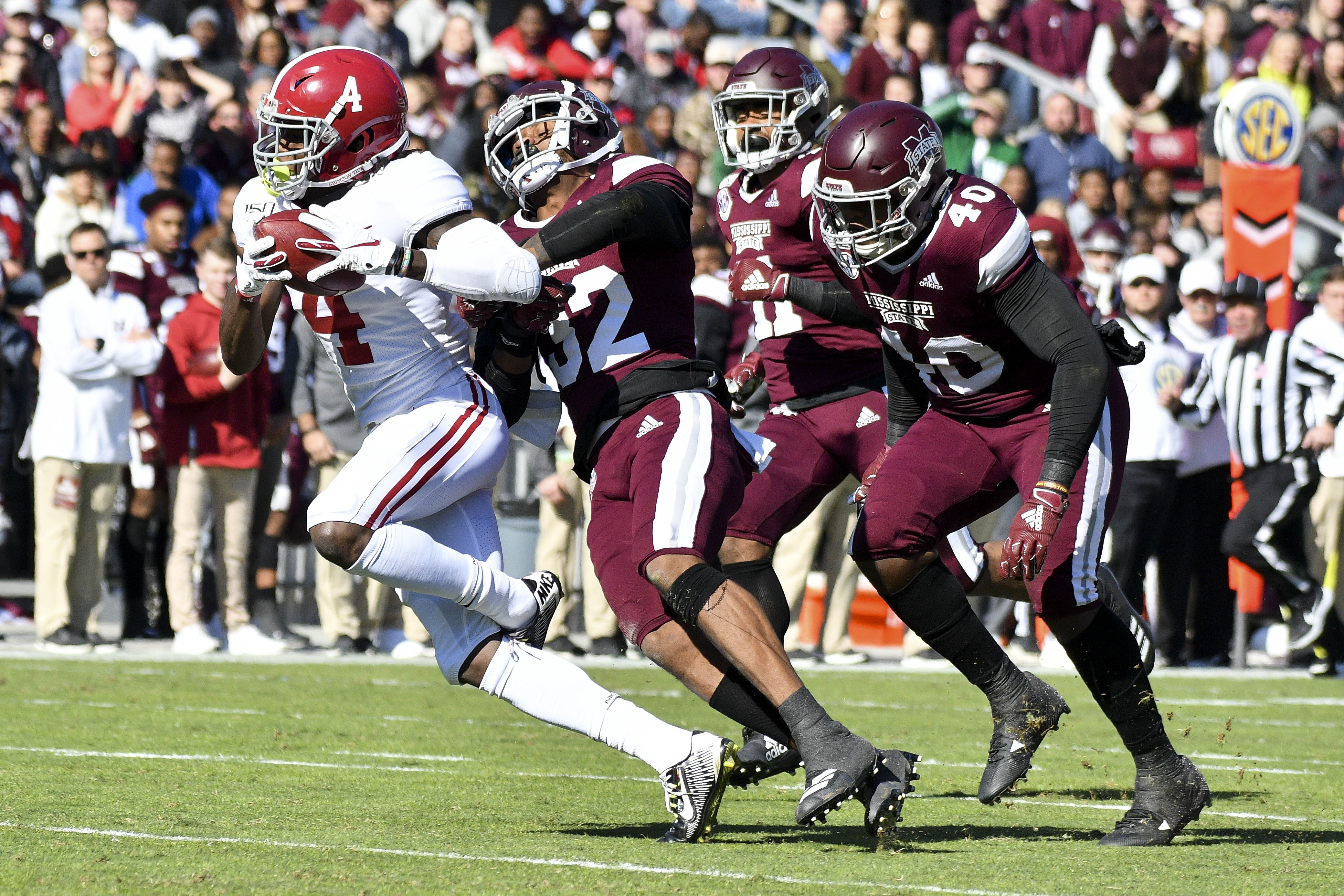
1. Jerry Jeudy, Alabama (Jr.)
| Ht. | Wt. | 40 time | 2019 stats |
|---|---|---|---|
|
6-1
|
193
|
4.45
|
77 catches/1,163 yards/10 TDs
|
Wulf (1): Just to start, my prejudices in evaluating wide receiver prospects favor underclassmen from Power 5 schools with at least one season of high-level production and at least one trait of elite athleticism because that's the path taken by the majority of the league's best receivers. If those boxes aren't checked, there needs to be an easy explanation for why.
Those benchmarks aren't a problem for Jeudy and CeeDee Lamb, and I'm torn on whom to rank atop the list, but I'm going with Jeudy because watching him made me laugh out loud more. He's such a ridiculous route runner — not in an "overachieving gym rat" kind of way but in a "that combination of precision and speed is just not fair" way. I think it's fair to question how much to ding Jeudy and Henry Ruggs III for playing in a loaded offense with a great quarterback, but I can't see Jeudy being anything worse than a very good starting NFL wide receiver. I will be surprised if he makes it out of the top 10.
Berman (1): Other than imposing size, Jeudy offers so much of what teams seek in a No. 1 receiver. He has the necessary speed, he’s a polished route runner, he’s dangerous with the ball in his hands and he plays all over the field. He finds ways to get open. He had major production in a loaded offense for two consecutive seasons. He won’t make it to the Eagles, but Jeudy should be their top option if they could have anyone.
Advertisement
Kapadia (1): His elite skill is his route running. Jeudy knows how to set up defensive backs and he creates separation better than any wide receiver in this draft. He is a smooth mover and has a great feel for finding holes in zone coverage. Jeudy is not a burner, but he can accelerate after the catch and has some wiggle. He lined up outside and in the slot for Alabama and had two years of high-level production. Jeudy is a physical player who will lower his shoulder on opponents rather than go out of bounds. Unfortunately for the Eagles, there's no chance Jeudy falls to No. 21, and it's highly unlikely he drops to a point where they would consider trading up.
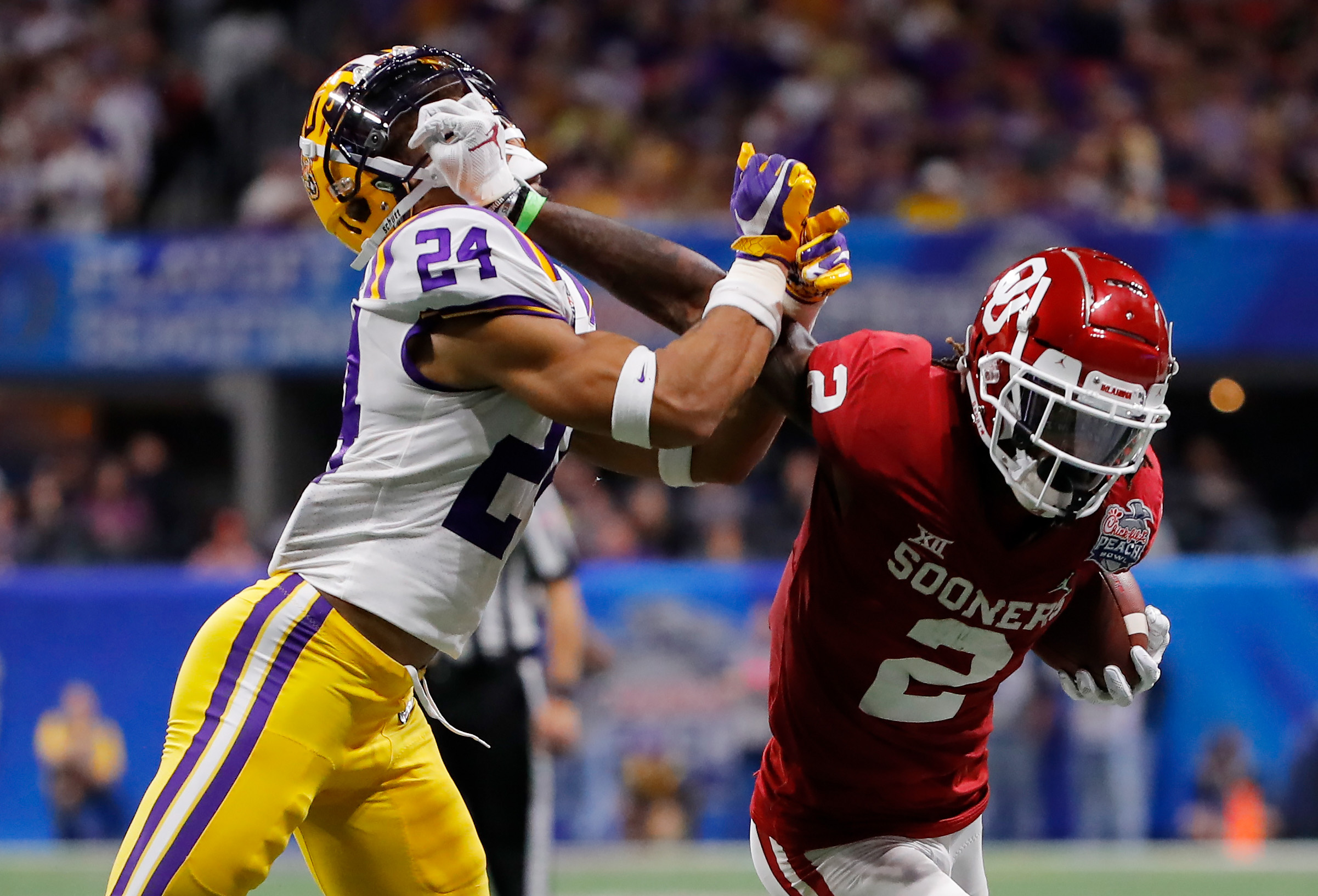
2. CeeDee Lamb, Oklahoma (Jr.)
| Ht. | Wt. | 40 time | 2019 stats |
|---|---|---|---|
|
6-2
|
198
|
4.5
|
62 catches/1,327 yards/14 TDs
|
Wulf (2): Compared to Jeudy, Lamb is probably a little less explosive and is certainly less polished as a route runner, but he's the one who looked more like a different species on the field. You could argue his ability to "out-athlete" defenders will be tougher to execute in the NFL and you'd be right. It's also true that he played with two quarterbacks who became No. 1 overall picks and another in Jalen Hurts who will be drafted in the first three rounds. But I think those nitpicks are mostly just a way to pass the time. He's awesome, and there's no way he'll be within the Eagles' reach.
Berman (2): Another top prospect who’s unlikely to be available when the Eagles pick, Lamb was a bona fide big-play threat in Lincoln Riley’s offense at Oklahoma. That system can sometimes inflate statistics, but it’s hard not to be impressed by Lamb. He makes contested catches. He can make plays downfield (24 catches of 40-plus yards). He would be a top option on the Eagles. Don’t expect it to happen without a major trade.
Kapadia (3): I see three attractive skills with Lamb. One, he's great with the ball in his hands. He's a physical, tackle-breaking wide receiver who plays like he expects to get to the end zone on every touch. Two, he has great body control and will effectively fight for contested catches. And three, he plays with a competitive edge. That shows up when he gets the ball in his hands. He's not the route runner Jeudy is and doesn't possess the straight-line speed of Ruggs, but he is an exciting playmaker. Like Jeudy, he's unlikely to be an option for the Eagles.
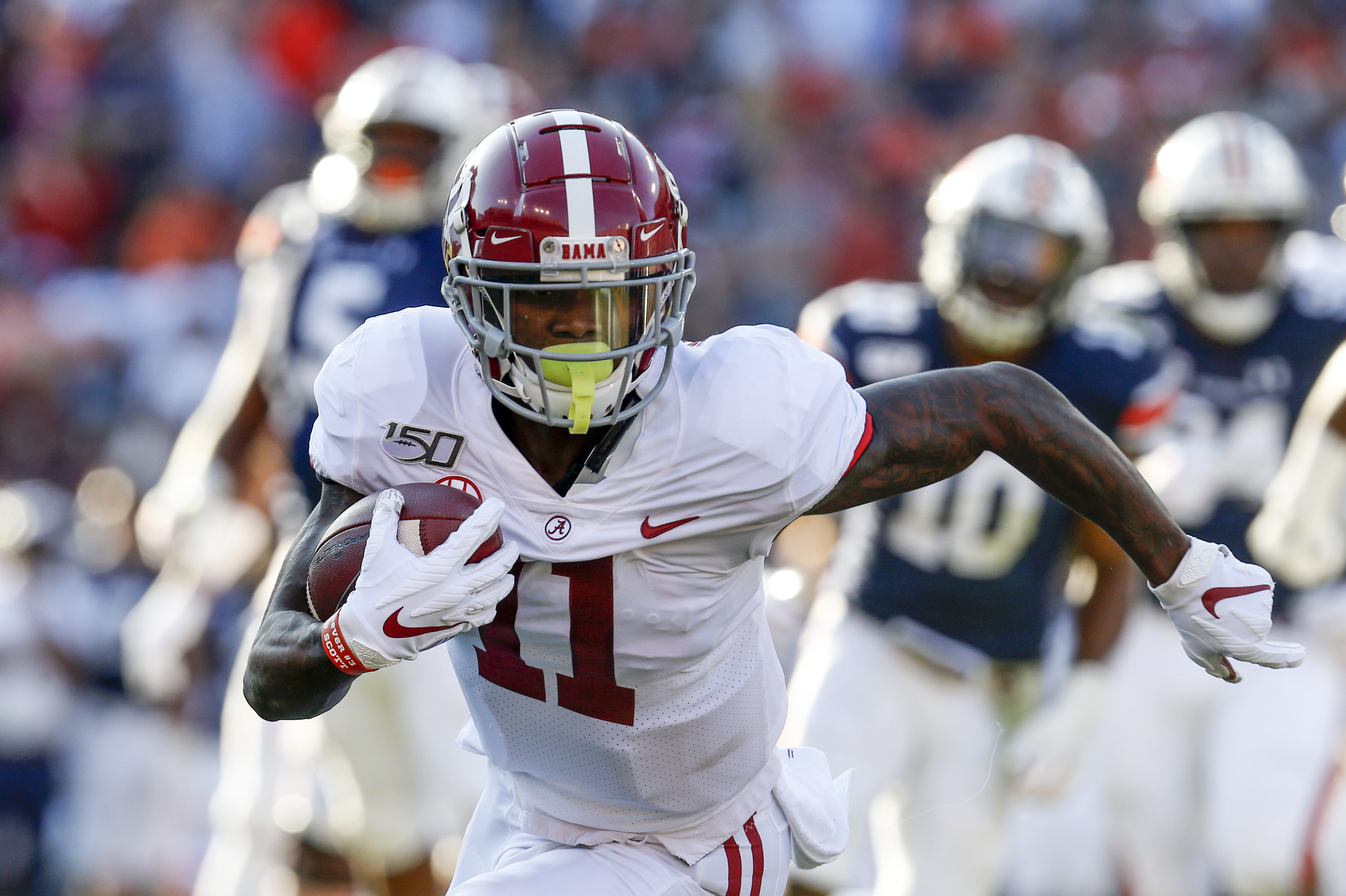
3. Henry Ruggs III, Alabama (Jr.)
| Ht. | Wt. | 40 time | 2019 stats |
|---|---|---|---|
|
5-11
|
188
|
4.27
|
40 catches/746 yards/7 TDs
|
Wulf (3): The only question with Ruggs is why he never topped 750 receiving yards. But it's hard to care when watching him run. He has that DeSean Jackson thing — when he hits top speed in the open field, it looks like he's leaping in slow motion with long strides while everyone around him looks stuck in mud. I didn't see much make-you-miss juking from Ruggs, but that's probably not necessary if you can just run by everyone. The Eagles offense would change shape immediately with his speed, but so would every other offense in the league, and that's why there's no way he'll be available at No. 21.
Berman (3): If I just wrote “speed,” do I need the rest of the blurb? It’s simplistic to limit the appeal of Ruggs to a 4.27-second 40-yard dash, but ... he ran a 4.27 in the 40! And that’s not just track speed. That’s on-field speed. Just like Jackson was advertised as a touchdown threat every time he touched the ball, consider this: Ruggs reached the end zone every 4.1 catches he made at Alabama. And he averaged 29.8 yards per touchdown. If you’re wondering why there wasn’t more volume, it’s easy to explain — look at the other receivers in the offense. He’s said to have the type of competitive personality to match the world-class speed. In an ideal world, the Eagles land him at No. 21. But speed doesn’t usually fall far in the draft.
Kapadia (2): I was on the fence but decided to place Ruggs above Lamb for the Eagles because of his upside. Ruggs ran a 4.27 and tested in the 99th percentile athletically. I would have liked to see more production out of him, but Ruggs still averaged 18.7 yards per reception last season, and it's easy to project how his skill set should translate to the NFL. Ruggs is a constant threat to get vertical. He excels on sideline routes — fades, comebacks and back-shoulders. He accelerates as well as any wide receiver in this class and can win on contested catches. Ruggs reminds me a bit of Brandin Cooks. He would give the Eagles elite speed on the outside and big upside. But again, he's unlikely to fall to No. 21.
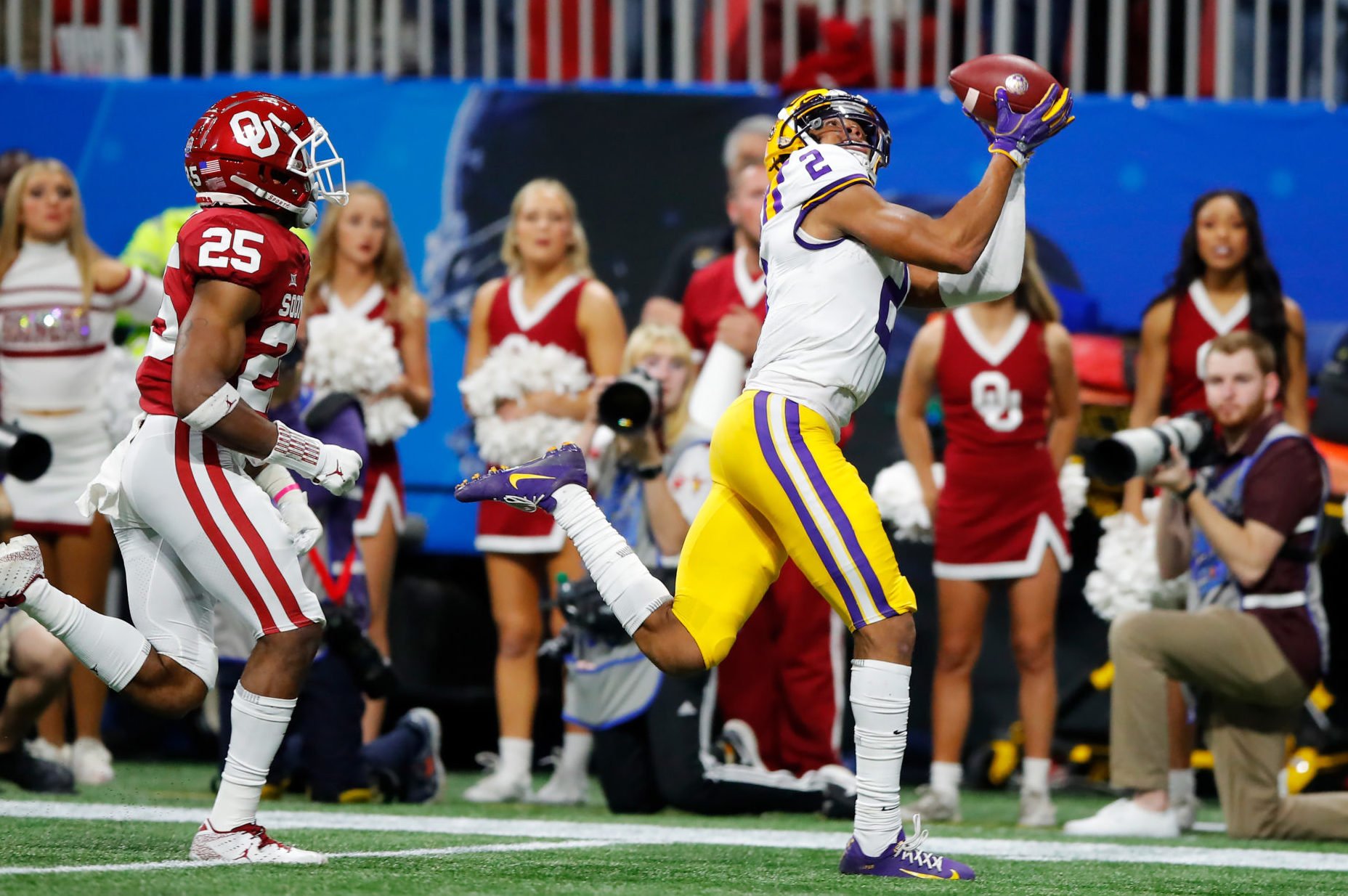
4. Justin Jefferson, LSU (Jr.)
| Ht. | Wt. | 40 time | 2019 stats |
|---|---|---|---|
|
6-1
|
202
|
4.43
|
111 catches/1,540 yards/18 TDs
|
Wulf (4): I think Jefferson can look a tad underwhelming on the field because the LSU offense made everything look so easy, but he checks every box. In two years of playing time as a true sophomore and junior, he averaged over 1,200 receiving yards. He played on the outside as a sophomore before exploding in the slot as a junior. He ran an unexpectedly fast 4.43-second 40-yard dash and tested above the 75th percentile in both the vertical and broad jumps. Ruggs and Denzel Mims were the only other wide receivers at the combine who topped the 75th percentile in all three tests. That's not to say he's fourth on my board because of his testing numbers, but that performance soundly answered any questions about his athleticism. He's the safest bet after the top three, and his versatility would give the Eagles some options for how to fill out their group of wide receivers.
Berman (5): There’s much to like about Jefferson: size, testing speed, production and playing style. His skills should translate well. At the least, he’ll help you in the slot. But what’s his ceiling? If he becomes Keenan Allen, that’s an outstanding result. If he becomes Jordan Matthews, that’s a fine result, albeit not the difference-maker the Eagles require. They need this draft pick to be a Day 1 contributor with No. 1 wide receiver upside. So, the evaluation must include projection of how he’ll play on the outside because most of his 2019 production came in the slot.
Advertisement
Kapadia (6): He may have been the toughest wide receiver on this list to slot, and ultimately, I came down lower on him than Bo and Zach. One factor that made evaluating Jefferson difficult was that his quarterback play with Joe Burrow was so much better than anyone else on this list. On paper, Jefferson makes a lot of sense. He had two years of high-level production and possesses all the measurables. Jefferson's elite skill is his feel for reading coverages and knowing how to get open. He consistently found holes versus zone, showed good hands and displayed tremendous body control on contested catches. Jefferson is tough, can make catches in traffic and will lower his shoulder against opposing defensive backs.
So why don't I have him higher? I think Jefferson projects best as a slot receiver who can work the intermediate middle of the field. The Eagles already have two tight ends who do that pretty well. I think they need someone who offers more of a vertical threat. Jefferson tested well, but I didn't think his athleticism jumped off the screen during games, and I didn't see someone who's special with the ball in his hands. In terms of past Eagles players, I see Jefferson somewhere between a more athletic Jason Avant and a version of Nelson Agholor with better hands and the ability to track the ball downfield. I don't think he'd be a bad pick, and, in the right offense, he could become a high-volume, go-to target. But I think a couple of the guys below have more upside.

5. Jalen Reagor, TCU (Jr.)
| Ht. | Wt. | 40 time | 2019 stats |
|---|---|---|---|
|
5-11
|
206
|
4.47
|
43 catches/611 yards/5 TDs
|
Wulf (5): Reagor tested in the 97th and 98th percentile, respectively, in the vertical and broad jump, but then ran a 5th-percentile three-cone time. I think that's actually how he plays. His straight-line explosion is impressive, and I like that he's more than a run-by-you wide receiver. Despite his height, Reagor won a lot of balls at the catch point in addition to the ones in which he blew by defenders. He also gets a pass for the drop in production from his sophomore year (72 catches for 1,061 yards) to his junior season (43 catches for 611 yards) because of TCU's truly heinous quarterback play. There's some swagger that I like, too. But he's not quite as dynamic as you would like for a first-round wide receiver at his size. I think he's a short DK Metcalf, which is probably good enough.
Berman (7): Of the wide receivers on this list, Reagor was most hindered by his offense during the past season. His 2018 production was a better indicator of his potential. When you see him in person, it’s clear he’s powerful for the position. More height would be preferable, but he has big-play ability and would help the Eagles as downfield threat. He’s also dynamic in the return game, averaging 17 yards per punt return in three years at TCU. His father, Montae, played for the Eagles.
Kapadia (4): I have Reagor ahead of Jefferson and think he could be a realistic option with the 21st pick. Reagor was hurt last season by bad quarterback play, but in 2018, he had 72 catches for 1,061 yards and nine touchdowns. He ran a 4.47-second 40-yard dash and has a 42-inch vertical, and his athleticism shows up on the field. He can fly on vertical routes and has the best "make you miss" ability of any wide receiver on this list. Reagor can line up outside or in the slot and can be used on jet sweeps and reverses. A good route runner, he can separate, high-point the ball and make twisting, contested highlight catches. Reagor would be a great option for the Eagles in the first round and projects as someone who could contribute right away and offer big long-term upside.
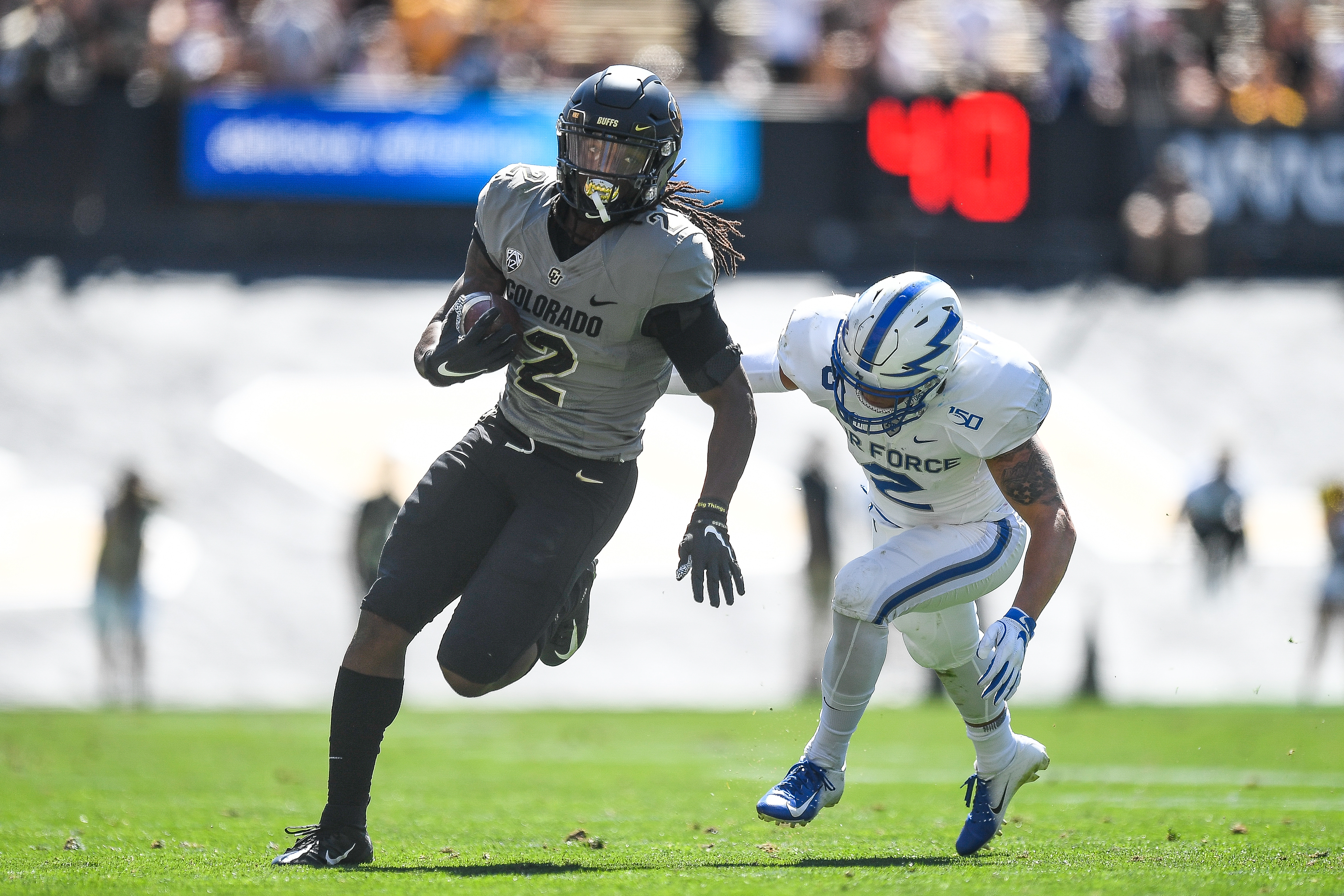
6. Laviska Shenault Jr., Colorado (Jr.)
| Ht. | Wt. | 40 time | 2019 stats |
|---|---|---|---|
|
6-1
|
227
|
4.58
|
56 catches/764 yards/4 TDs
|
Wulf (9): I'm interested to read Zach's write-up because I don't get it with Shenault at all. Setting aside the extensive injury history made more troublesome by his style of play, Shenault looks like an unpolished wide receiver who did his best work near the line of scrimmage on pop plays. The Eagles don't need more players who need the ball within the first 10 yards, and I'm generally wary of players who will need their touches manufactured. I think he's a thick, slow Tavon Austin.
Berman (4): Clearly, I think more of Shenault than my colleagues. And I don’t expect the Eagles to take him in the first round because I can’t imagine they’ll invest in someone there with injury concerns after what they've endured the past few seasons. But if I had to rate these players by Pro Bowl potential, there wouldn’t be many names before Shenault. That’s why I ranked him so highly, because if he’s healthy and develops, the ceiling is stardom. He’s special with the ball in his hands; 58.1 percent of his receiving yards came after contact. If you watched him against Nebraska in 2018, it probably left a lasting impression. The medical staff evaluation would factor heavily, but if he’s playing in Pro Bowls one day, don’t be surprised.
Kapadia (7): He fits the mold of a "just get the ball in his hands" type of wide receiver. Shenault can line up outside or in the slot. He's a tackle-breaking machine who is also elusive. Shenault has good short-area quickness and was used on direct snaps, jet sweeps and other runs at Colorado. He will run over defenders and plays with a physical, tough demeanor. Most of his work came in the short and intermediate parts of the field, but he also showed the ability to track downfield passes. He's probably the closest comparison to Deebo Samuel in this year's class. Shenault is a lot of fun to watch, but the durability issues are concerning given his style of play.

7. Tee Higgins, Clemson (Jr.)
| Ht. | Wt. | 40 time | 2019 stats |
|---|---|---|---|
|
6-4
|
216
|
4.54 (Pro Day)
|
59 catches/1,167 yards/13 TDs
|
Wulf (8): Rich man's JJ Arcega-Whiteside doesn't look like a dynamic athlete to me, but I believe in his ability to make plays down the field more than I did with Arcega-Whiteside. I like Higgins as a prospect more than I do as a fit for the Eagles offense, which doesn't need to spend a high draft pick on a player with questionable ability to separate who wouldn't improve the lack of offensive spacing.
Berman (6): Another player I like more than Bo and Sheil. It’s easy to get Arcega-Whiteside fatigue and label Higgins as a jump-ball specialist, but he should be evaluated on his own accord. He has elite size and the longest wingspan of anyone on this list (81 inches), and he consistently made plays downfield — not just in the end zone. He averaged 18.1 yards per catch in his college career, which was the second-best rate on this list. In last season's national championship, he scored on a 36-yard reverse, getting to the edge and breaking tackles downfield. If not for the Arcega-Whiteside experience and the Eagles’ need for speed, the fan base would be excited about Higgins. He’ll be a productive wide receiver in the NFL.
Advertisement
Kapadia (8): There's a lot to like about Higgins. He was a productive college player and his differentiating skill is his catch radius. Higgins is 6-foot-4 with 34 1/8-inch arms. He displayed nifty footwork on sideline routes and can use his size to keep defenders on his back on slants and other in-breaking routes. Higgins is a good route runner who knows how to leverage defenders and he can win consistently in the red zone. With the right quarterback, he should be a monster on back-shoulder throws. Higgins ran a 4.54-second 40-yard dash at his Pro Day and he showed plenty of speed during games. Play strength at the NFL level is one concern. At times, opposing defensive backs disrupted his routes and shoved him toward the sideline. I don't know if Higgins is a perfect fit for the Eagles offense, but I like his potential as a starting wide receiver. A great outcome for Higgins would be some version of Plaxico Burress.

8. K.J. Hamler, Penn State (Redshirt So.)
| Ht. | Wt. | 40 time | 2019 stats |
|---|---|---|---|
|
5-9
|
178
|
N/A
|
56 catches/904 yards/8 TDs
|
Wulf (7): The speed is real, and the Eagles really need speed. I do have some reservations — the injury history, the relative lack of production compared to other top players in the class and the lack of size. He's really, really small. But he has real juice and would fill an immediate role as a downfield threat. With Hamler on the field, it would be a lot harder for defenses to commit extra resources to stopping the team's tight ends. The returner upside is a nice bonus. I have Hamler seventh on my list, but he's the last one I'd feel good about as the Eagles' first wide receiver drafted.
Berman (10): This ranking is too low based on the contribution Hamler could make, but I have him lower than Bo and Sheil, so I’ll address that. Hamler can be a dynamic player and a difference-maker with his speed. My question is whether he’ll be an every-down player who can be a high-volume receiver or if he’s a slot receiver who needs plays designed for him to maximize his skill set. If Hamler turns into Jackson, it’s a home run. If he’s Austin, it’s a miss, given what the Eagles need. And the drops are a concern; Hamler led the FBS with 12 last season. However, if the Eagles selected Hamler and then drafted a bigger wide receiver who can excel on the outside, it would be a nice match.
Kapadia (5): Hamler is probably the most polarizing wide receiver on this list. I went into this thinking I wouldn't be that high on him, but the more I watched, the more I liked. Hamler's speed shows up on vertical routes and crossers from the slot. He knows how to set up defenders and consistently creates separation. Hamler has the short-area quickness to be effective in the quick game and the speed to get open downfield. He has the "looks like he knows what he's doing" trait and plays with great effort and juice.
There are the obvious issues. For one, he struggled with drops last year. But that wasn't the case in 2018 when he had just three drops, per Sports Info Solutions. In terms of measurables, we have seen guys his size — T.Y. Hilton, John Brown, Jackson, Danny Amendola — have success. The one player Hamler reminded me of was Tyler Lockett. Lockett was 5-foot-10 and 182 pounds when he came out of Kansas State. Hamler probably has too many questions to be worth the 21st pick. But if the Eagles trade down or if he's available in the second round, I see him as an exciting option who can stretch the field from the slot while also being tough for opposing nickels to handle on third down.
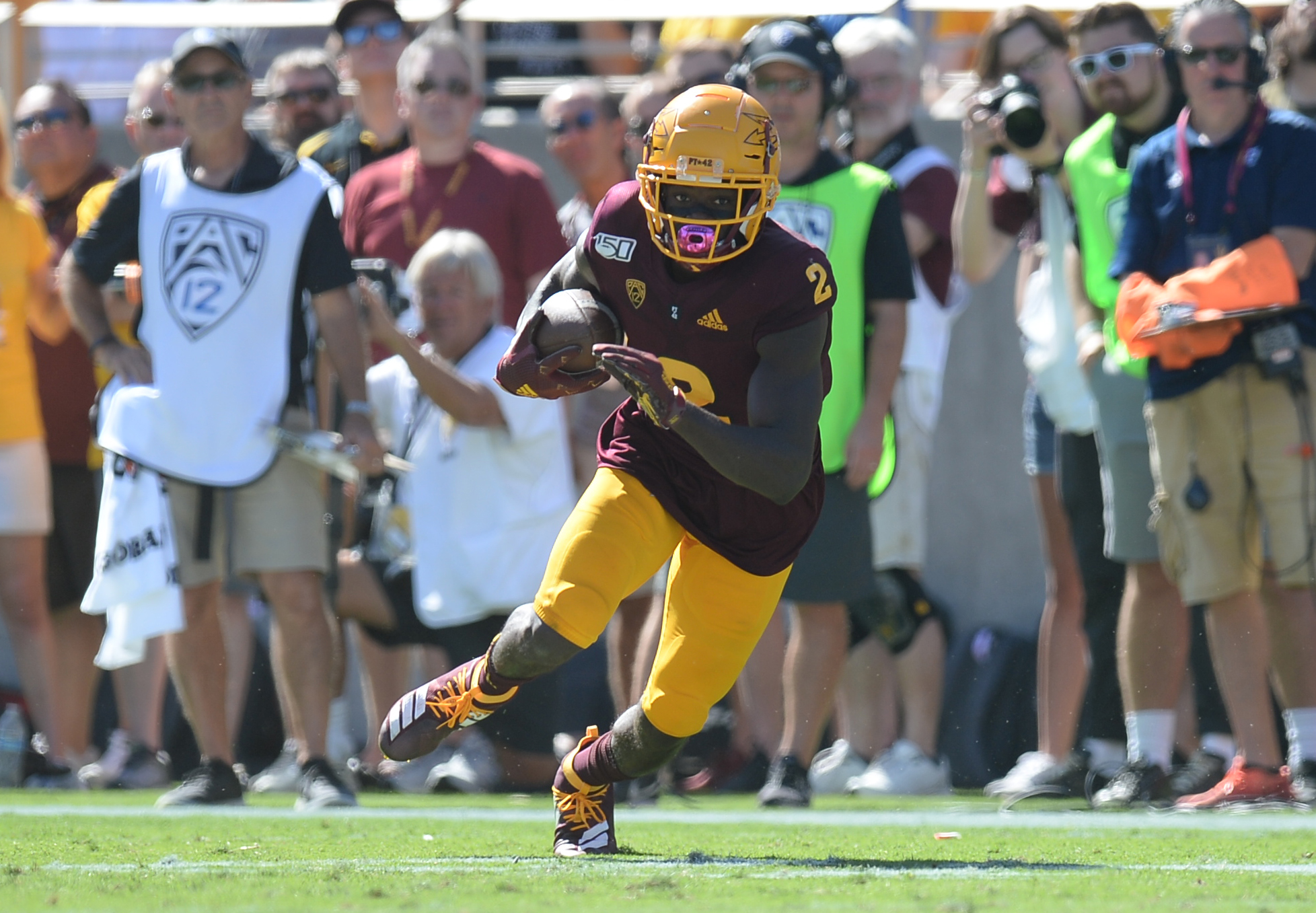
9. Brandon Aiyuk, Arizona State (Sr.)
| Ht. | Wt. | 40 time | 2019 stats |
|---|---|---|---|
|
6-0
|
205
|
4.5
|
65 catches/1,192 yards/8 TDs
|
Wulf (6): Based on profile alone, I would've rated Aiyuk ninth or 10th in this group. He's a touch older than the juniors at the top of the board, although that's easily explained because he started in junior college. He ran an underwhelming 4.5-second 40-yard dash at the combine, and I'm generally wary of wide receiver prospects billed with YAC-ability as their top trait because that's a lot easier to do in college than in the NFL. Add the core muscle surgery he had this week and it's not a perfect picture.
Then I watched Aiyuk play and had to completely re-evaluate. Outside of the clear top three, Aiyuk has been my favorite draft-eligible wide receiver to watch. Billing him simply as a YAC receiver undersells him completely. I saw someone playing at a different speed than everyone else on the field, not in his given straight-line speed but in the quickness with which he understood the space available around him. Mims, Reagor and Jefferson may have run faster 40s, but Aiyuk's transition from catch to next move looked much quicker to me than anyone in our top 10 except maybe Jeudy. And he won downfield, too. If I trusted my eyes alone, Aiyuk would be fourth in my list. But I'm not naive enough to think my eyes matter more than the rest of the profile, so I have him behind Jefferson and Reagor. I don't know if there's a better fit for the Eagles offense.
Berman (9): Aiyuk doesn’t have the extended body of work with only one season of major production as a featured wide receiver, but if the Eagles are looking for big-play ability, Aiyuk fits. He averaged 18.3 yards per catch last season and 11.1 yards after the catch, which is an attribute the Eagles could use. He’s also a productive returner. Aiyuk is reportedly undergoing core muscle surgery this week, so the Eagles would need to be satisfied with the medical evaluation. Is he a player who would be an every-down contributor from Day 1 or would he be confined to certain packages?
Kapadia (9): A lot of really smart people whose opinions I trust seem to think Aiyuk is a great sleeper option — even in the bottom half of the first round. But I don't totally get it. Aiyuk's best trait is his ability to pick up yards after the catch. But watching him, I wasn't sold on that translating to the NFL. A lot of his big plays at Arizona State looked the same: Aiyuk caught a pass on a slant, dig or some other in-breaking route, accelerated and got to the end zone. I didn't see him as someone who made defenders miss or physically overpowered them. And while his speed is fine, I'm not sure it's going to be a differentiating factor against NFL defensive backs. If there's a blurb on here that's most likely to make me look stupid two years from now, this is probably it. But I don't see Aiyuk as a great option for the Eagles.
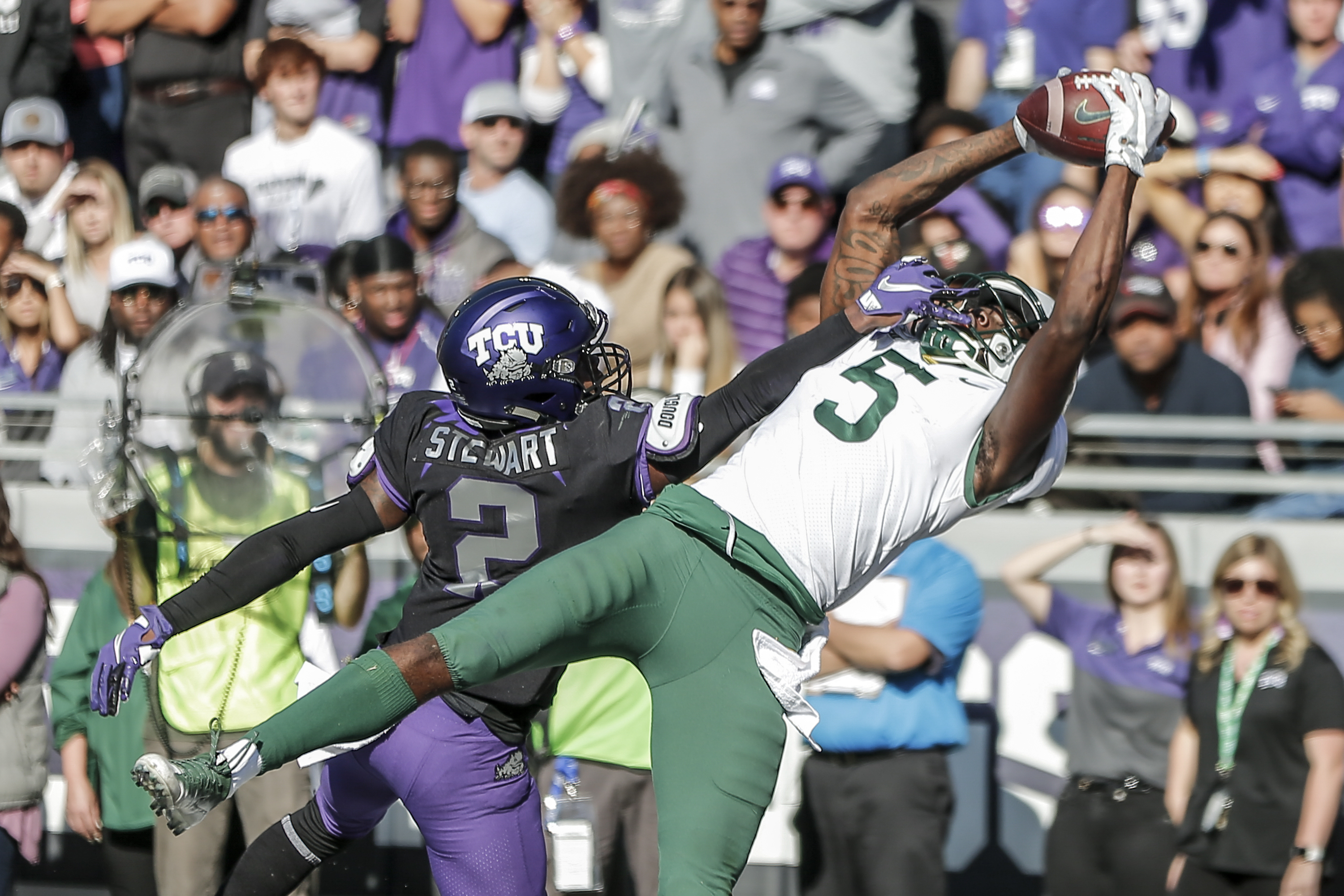
10. Denzel Mims, Baylor (Sr.)
| Ht. | Wt. | 40 time | 2019 stats |
|---|---|---|---|
|
6-3
|
207
|
4.38
|
66 catches/1,020/12 TDs
|
Wulf (10): I really liked Mims at the Senior Bowl and thought he was far and away the best player there at the position. He looked like a good option for the Eagles in the third round, maybe in the late second. Since then, the hype train has surpassed my level of comfort. Yes, Mims tested as an explosive athlete and ran a dazzling 4.38-second 40-yard dash at 6-foot-3 and 207 pounds, but I don't think he plays to that speed. He makes open-field decisions slowly and he fights the ball more than any wide receiver on this list. Sure, the upside is great if he puts together all of his physical tools, but he's both the rawest and oldest player in our top 10.
Berman (8): Mims has an appealing size-speed combination and the college production to match. There’s projection involved, but his athletic testing attracted attention and he has a track background, too. He was held without a catch in the Big 12 championship game before rebounding in the Sugar Bowl with 75 yards and a touchdown. There’s projection about how he'd be used with the Eagles because of Baylor's different offensive style. Mims would be a fine pick, although it shouldn’t prompt a parade down Broad Street just yet.
Advertisement
Kapadia (10): The measurables are great. Mims possesses a rare blend of size and speed, and he was productive. But I didn't see his athleticism consistently show up on the field, and I have concerns about Mims' ability to separate against man coverage in the NFL. He has a big catch radius and knows how to use his size. When Mims gets a head of steam, he's tough to bring down. But I didn't see him consistently overpower defenders. I never felt like I was watching a particularly explosive athlete or a burner. Given the concern about his ability to separate, I don't think he'd be a good fit for the Eagles.
More coverage: Eagles draft
(Top photo of Justin Jefferson: Jonathan Bachman / Getty Images)
